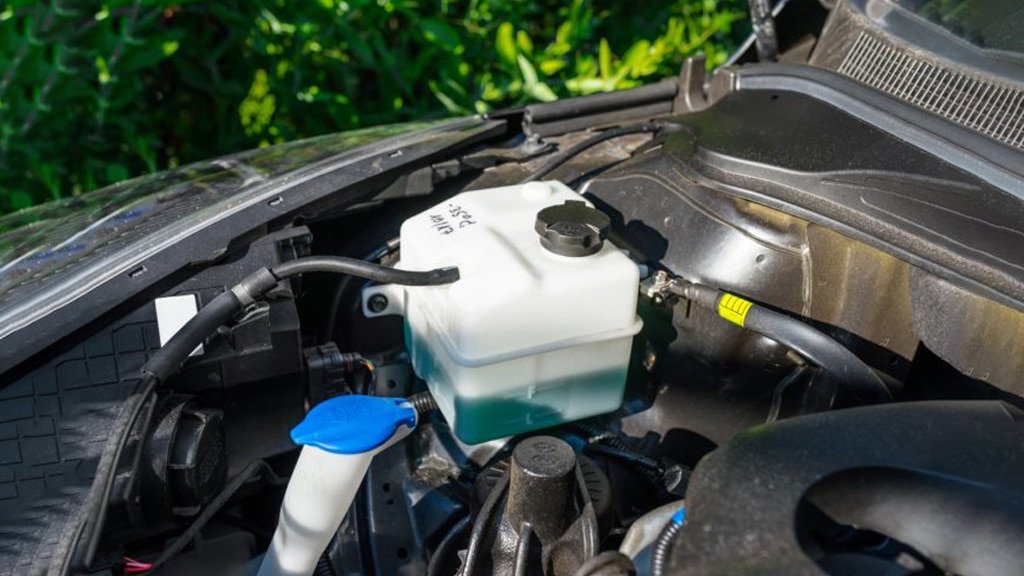Coolant leaks can crop up anywhere in your entire cooling system. Usually, coolant leaks are pretty straightforward because you can often see exactly where the coolant is dripping, spraying, or bubbling from. Some vehicles include a Low Coolant indicator on the dashboard. If your car does not, the first sign of coolant problems is commonly an engine that starts overheating. If your vehicle seems to be losing or leaking coolant, start by opening your hood and taking a close look at the engine and cooling system components for signs of leakage around any area of the engine, radiator or hoses. The color of the liquid you find leaking could be green, orange or even yellow depending on your choice of antifreeze that has been used in your cooling system. Because antifreeze is made of ethylene glycol, it may also have a sickly sweet smell as well.
Most Common Places for Coolant Leaks
Water pump
A bad shaft seal allows coolant to escape from the vent hole located just under your water pump pulley shaft. With a two-piece water pump unit that has a backing plate, the gasket found between the housing and back cover could also be your culprit. If you have a cover-mounted water pump, your gasket or o-ring sealing the pump to your engine front cover could also potentially leak coolant. You need to look for any stains, discolored areas and/or liquid coolant that may be on the outside of your water pump or engine.
Radiator
Radiators often have leaks occur around both upper and lower hose connections. This often happens due to vibration. Another area known to leak is the seams where the core is mated to the end tanks. This is especially true for models with aluminum radiators and plastic end tanks. On copper or brass radiators, leaks often occur where cooling tubes in the core connect or are soldered to the core headers. The core itself is even susceptible to stone damage. If you haven’t been flushing your radiator, you may have internal corrosion that is caused by old, unchanged coolant. It eats through the metal of your radiator creating areas that become weak enough to leak.
Most cooling systems are made to operate at anywhere from 8 to 14 psi. If your radiator is unable to hold the specified pressure, the engine will overheat and begin to lose coolant.
Hoses
Cracks, splits, and even small pinholes in your radiator hose or heater hose leaks coolant. Hoses that have started to leak often stream burning hot coolant or spray it right out of the hose in a noticeable way. A hose connection that is corroded or a hose clamp that has become loose or damaged can also be to blame for coolant leaks located at the end of a hose. In some cases your leak only occurs after the hose has heated up enough to allow a tiny hole or crack to open. Be sure to pinch the hoses checking for cracks from age, any hardening, soft spots, blisters or unusual bulges.
Freeze plugs
These are also known as casting plugs or expansion plugs and they are found in the sides of your engine block and/or the cylinder head. These flat steel plugs become corroded from the inside out, and have been known to develop leaks. Leakage from this particular area is sometimes hard to see because of the location of the plug. They are most commonly found behind your exhaust manifold, the engine mount or one of your other engine accessories. On vehicles with V6 and V8 blocks, the freeze plugs are best inspected from beneath the car.
Heater Core
Your heater core can be found inside your heating ventilation and air conditioning or HVAC unit that is under your dashboard. If your heater core is leaking, or if a hose connection that goes to your heater core is leaking, coolant will seep out of the bottom of your HVAC unit. The leak usually drips on the floor of your car inside the passenger compartment. Inspect for any stains or wet areas located on the bottom of the plastic HVAC case and on the floor of your passenger side.
Intake Manifold gasket
The gasket sealing your intake manifold to the cylinder heads can leak. It may allow coolant to get into the intake port, the crankcase or drip down the outside of your engine. If the intake manifold gaskets on your engine are plastic, they may routinely fail at 50,000 to 80,000 miles.
If you need help locating your coolant leak stop by Sanford’s Automotive Service to let our ASE Certified Master Mechanic get you taken care of quick! Call 803-735-7902 to set up an appointment now. Our auto repair shop in Columbia, SC Auto repair has been the best choice for quality auto repairs and superior customer service since 1989. Come in today and let us make a loyal customer out of you!

